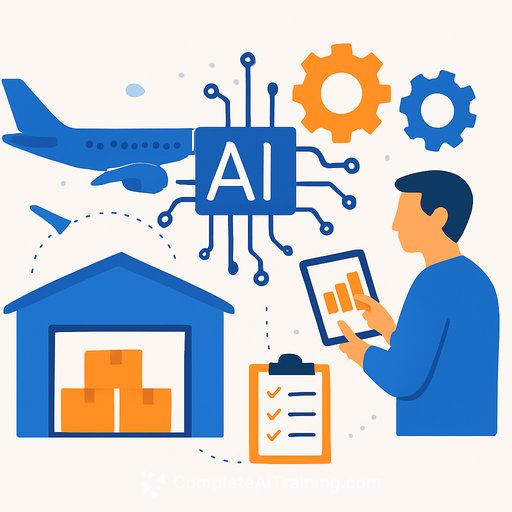DeepRoute.ai Plans Consumer-Grade Robotaxi Operations by End of 2025: What Ops Leaders Need to Know
DeepRoute.ai plans to launch robotaxi services using consumer-grade production vehicles by the end of 2025. For operations teams, that means lower unit cost, shorter launch timelines, and a cleaner integration path than the custom-built AV fleets used by many pilots.
The company's stack already runs in roughly 150,000 production vehicles for consumer assisted driving in China, with more than 200,000 expected by year-end. Backed by over $500 million from investors including Alibaba and Great Wall Motor, the move signals a shift from prototype-heavy deployments to repeatable, OEM-embedded operations.
What's Different About the Model
- Production vehicle platform: The robotaxi tech and the mass-produced vehicles share the same core stack. That consistency makes validation, maintenance, and updates more predictable at scale.
- Lower hardware and integration costs: AV systems are integrated during manufacturing, avoiding retrofit budgets and the downtime they create.
- Map-free navigation: No high-definition map licenses or recurring map upkeep. This removes a major fixed cost and reduces lead time for new-city launches.
- Fleet learning loop: Insights from a large consumer fleet feed improvements into the robotaxi platform, strengthening performance across diverse urban environments.
Quote Worth Noting
"A key strength of DeepRoute.ai's approach is that its robotaxi platform and mass-produced vehicles are built on the same core technology framework, enabling a high level of consistency and seamless platform interoperability," said Maxwell Zhou, CEO of DeepRoute.ai.
Operational Implications
- Procurement: Treat vehicles as standard SKUs sourced via OEM partners, not custom builds. Expect fewer unique parts and simpler spares planning.
- City launch playbook: Without HD map prep, time-to-first-ride can compress. Focus resources on site readiness, permitting, and safety case approval.
- TCO shift: Capex and recurring map fees come down; software, data, and compliance move up the cost stack. Budget accordingly.
- Maintenance ops: Use OEM service networks where possible. Standardized components simplify uptime management and parts logistics.
- Safety and risk: Build an intervention-free operations target with clear thresholds for remote assist and disengagement. Align incident investigation processes to local rules.
- Data operations: Prioritize over-the-air update cadence, regression testing, and audit trails for regulators and insurers.
- ODD management: Define operational design domain by time, weather, and zone. Expand in staged releases based on real performance, not assumptions.
- Localization: Europe, Japan, and South Korea require language, signage, and policy localization. Plan for local operating entities and partnerships.
Markets and Timing
DeepRoute.ai is targeting a launch by the end of 2025 and is building a European presence to support localization and partner engagement. Europe's labor costs and policy environment, along with driver shortages tied to aging populations in Japan and South Korea, create favorable conditions for ride-hailing automation.
If you operate in Europe, align your compliance plan with emerging guidance on automated and connected driving. A good starting point: the European Commission's overview on road transport automation. Read the policy context.
KPIs to Track from Day One
- Cost per vehicle mile (by weather, time, and zone)
- Revenue per mile and trip margin
- Disengagements and remote assist rate per 1,000 miles
- Reportable incidents per 100,000 miles
- Vehicle uptime and maintenance turnaround time
- ODD coverage hours vs. service demand
- Customer wait time and on-time pickup rate
- City launch lead time (permit to first paid ride)
- Map maintenance cost (should be near zero with map-free)
Integration Checklist for Ops Teams
- Network planning: Choose first neighborhoods using trip density, depot access, and charging availability.
- Facilities: Secure depots with power, secure parking, and 24/7 access. Co-locate maintenance where OEM capacity exists.
- Charging strategy: Peak/off-peak scheduling and redundancy. Validate utility interconnect lead times early.
- Safety case: Build a documented safety management system, test plans, and incident response playbooks.
- Insurance and liability: Confirm coverage models for driverless operations and software updates.
- Dispatch and payments: Integrate APIs for ride requests, pricing, and customer support workflows.
- Data governance: Define retention, access control, and regulator audit paths.
- Public engagement: Coordinate with city officials, transit, and accessibility groups ahead of launch.
- Workforce: Train field ops for pre-trip checks, remote assist, and recovery procedures.
Risks and Unknowns
- Regulatory swing: Approval timelines vary by city and country; requirements can shift with new guidance.
- Edge cases: Map-free systems must handle temporary road changes, signage variance, and complex intersections.
- Supply constraints: OEM production slots, sensor availability, and service capacity may bottleneck scaling.
- Unit economics: Pricing pressure from ride-hail incumbents and public transit integration can affect margins.
- Public acceptance: Early incidents or service outages can slow permits and demand.
Bottom Line
By using consumer-grade production vehicles with a shared core stack, DeepRoute.ai is pushing robotaxi operations toward repeatable, lower-cost deployment. For operations leaders, the opportunity is to lock in a city-by-city launch playbook now: compliance, facilities, charging, safety, and data-then scale with discipline as the ODD expands.
If your team is building new automation capabilities around AV operations, this practical training path can help you upskill quickly: AI Certification for Automation.
Your membership also unlocks:






